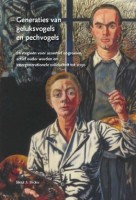Bonus Chapter added to the Book on Generations – Bonus Chapter 15: Frequently Asked Questions
No comments yet15.1 General questions
15.2 Questions regarding theories
15.3 Questions regarding methods
15.4 Further questions
This set of frequently asked questions and related answers will be updated regularly. A Dutch translation will be supplemented shortly.
15.1 General questions
Could essay contests release the potentials of European Years’?
Frequently ‘European Years’ have been organized already by the European Commission, supported by NGO’s. Until today, these annual campaigns did trigger little attention only in the member states and the Union as a whole. Each European Year a number of projects is organized in support of the event, but these projects also do not result in much attention. Consequently, the European Years are in need of an additional campaign that presents an overall image and charisma. The additional campaign will also have to present an integrated overview of the projects financed in the European Year.
In the European Year 2012 the theme is: ‘active ageing and solidarity between generations up to 2020’. The first component requires attention to the specific characteristics of the generations of seniors involved in the period 2012 to 2020. The second component implies co-operation between members of generations, but also social justice between generations. This component is closely related to the concept of sustainability. This is because sustainability is defined as ‘fair play’ between generations. The third component is related to the policy document ‘Europe 2020’, issued by the European Commission. This policy document advocates strategies for smart, sustainable and inclusive growth up to the year 2020. In support of EY2012 the EC has made available two documents: ‘2012: Everyone has a role to play’ and ‘Manifesto for an Age-Friendly European Union by 2020’.
The theme for EY2012 requires substantial background information regarding the knowledge and know-how on generations in society provided by the social sciences. Regarding this background information this book has become available.
Essay contests have been applied with positive outcomes in the past, as we saw in chapter 12. For instance essay contest focussing on the analysis of threats and opportunities. Looking not only for a problem analysis but also for problem solutions. With regard to the European Year 2012, essay contests organized to achieve these aims are proposed.
In EY2012, essay contests are proposed to focus inter alia on the following categories:
– Youngsters in secondary education.
– Students in higher education.
– Members of senior and junior generations co-operating in organizations.
Furthermore, dialogues are proposed to be held between directors of projects financed in the course of EY2012 and members of junior generations. These dialogues will have to demonstrate theintegration of the projects in the EY2012 campaign as whole.
In 2012, the essay contests will be organized as a pilot, as a try out, on a limited scale only. The theme for EY2012 will play a major role. The experiences gained with this campaign will enrich the campaign in EY2013 on ‘citizens’. They will also prove to be valuable for organizing later EY’s. Primarily because two components of EY2012 will be continued in later EY’s. First: solidarity between generations, taking into account co-operation between generations but also social justice between generations. Second: The strategy advocated in ‘Europe 2020’, aiming at smart, sustainable and inclusive growth, defining sustainabilty as ‘fair play’ between generations.
In EY2012, the essay contests will be held in each member state that decies to participate. A jury in each participating member state will select candidates for a longlist. An international jury will select candidates for a shortlist and following this will select the three winners in each of the above categories, to be presented at the international essay festival, to be held in the Fall of 2012.
I will return to issues related to the proposed essay contests later on in this chapter.
Why is this book called ‘a living document’?
A living document can be supplemented or rewritten after its formal publication. The author gets an opportunity to change his book. In a restricted format readers are allowed to supplement information. A wider format allows readers to contribute to a rewriting the book. In this book, readers are invited to react according to the restricted format. Their contributions are invited by Twitter (@beckerhenk).
First, in this bonus chapter new developments will be documentend. The pattern of generations does freqently change in many countries. New publications become available and a selection require to be added to the book.
Second, reactions from readers often require an answer. Reviews in journals can be based on mistakes. As an example I would like to draw attention to a review of the manuscript in which the absence of notes in the book was criticized. The reviewer evidently was unaware of the fact that in the book the APA style (American Psychological Association) is applied. The APA style abstains from notes in scientific publications.
Third, the book will have to play a role in a number of campaigns. The contributions to the campaigns will require discussions. As an example we mention 2012 …
What is so special about the painting of ‘The three Generations’?
Generations in society have been seriously discussed first by Wilhelm Pinder in Das Problem der Generationen in der Kunstgeschichte Europas (Berlin 1926). It was no coincidence that Pinder discussed generations in art history. Art historians have a tradtion of identifying generations of painters and other artists and presenting descriptions of these generations. The painting by Charley Toorop is dated 1950. We see three representatives of three generations of painters in the year 1950. A member of the generation of impressionists: Jan Toorop. A member of the generation of realists: Charley Toorop. A member of the generation of magic realists (later becoming a member of the generation of abstract painters): Edgar Fernhout. The knowledge we have in general about the pattern of generations of painters provides us with an opportunity to understand what Charley Toorop had in mind when she called her painting ‘The three Generations’. Of course she also confronted us with a painting of a father, a daughter and a son. If we look at a pattern of generations in society consisting of senior generations, midlife generations and junior generations, we do not have enough information about this pattern to be able to describe and discuss it without further information.
Pinder demands attention for ‘the non-contemporaneity’ of the ‘contemporaneous’ (Becker, 1990, p.6). His most powerful example is the observation that manneristic paintings paintings by Greco as well as high-baroque paintings by Robens come from the samen time. Pinder argues that the period in which artists are born, grow up, and are educated, has a strong influence on the problems which they put forward after their education and during their working life. The sense of belonging to a certain birth Group unites artist. ‘Es gibt ‘Generationen’ von normalerweise überwiegend einheitlichem Problemcharakter, Generation ist ein Stilwert’, according to Pinder (1926, 27).
Pinder sees a generation of artists being characterized by a common ‘entelechy’, literally meaning the pursuit of a common aim. Basically, Mannheim agrees with Pinder, but he reproaches him with romantic immoderation and an over-schematizing of the history of arts on the basis of the generations he has identified.
As soon as we look at patterns of generations outside the area of art, we do not find generations specified as far as in the history of art. In chapter 1 of this book we have introduced the concepts of general and specific generations. In most cases members of society have learned about stereotypes for each of the general generations that exist in social reality. In some cases patterns of specific generations show stereotypes also. These stereotypes are not cristallized as much as in art history and therefore there are no paintings that could inform us sufficiently about the characteristics of the generational patterns we are interested in. In stead of looking at a painting we will have to reflect on our stereotypes and to study research reports and discursive descriptions.
Are we our brains, but just as well our generation?
In 2010, Dick Swaab, a brain researcher, published We are our Brains, from womb to Alzheimer (Wij zijn ons brein: van baarmoeder tot Alzheimer). His book became a bestseller in the Netherlands. From conception untl death, Swaab systematically described how our brain dominates our behaviour. He writes about the relationship between nature and nurture and he stresses the importance of nature in the balance between these two extremes.
The impact of this book is primarily to be explained by its dialectical approach. Each reader has to reflect himself or herself on the balance between nature and nurture. Without this fascinating dialogue the book would have attracted much less attention.
Are we our brains, but just as well our generation? In our opinion, this question has not been asked frequently enough. We expect that in the near future already this question will arise on a large scale. Which aspects have to be taken into consideration?
First, we will have to look again at the ideas of Goethe cited in the first chapter of this book: ‘Each of us, born ten years earlier or later, would have become a completely different person with regard to education and image’. In the social sciences, a substantial number of research projects has looked at ‘birth and fortune’. As an example I mention the book by Richard Easterlin: Birth and Fortune (1980). Easterlin has focused inter alia at ‘the accident of birth: generation size and personal welfare’, also at ‘the economic fortunes of young adults’. One of his conclusions reade: ‘Those whose year of birth brought them to the labor market in a period of mass unemployment often were scarred for life’. (p. 145).
Second, the formative period in the lifecourse requires our attention again. In the first chapter we learned that research has shown serious impacts. Intelligence and memory capacity of individuals are influenced by major events in society occuring during their formative years. Also research on technology generations indicates that confrontation with technological change in the formative period often has lasting effects on the behaviour of individuals, as we saw in the first chapter.
Third, the fate of each generation in the course of its existence has to be explored, often to be followed by action. To minimize inequality between generations. To minimize the wasting of opportunities.
15.2 Questions regarding theory
Which models of empirical research and theoretical explanation have been applied in the book?
I expect quite a lot of questions regarding the models applied in the book and for that reason I will summarize them shortly.
As an axioma I take the statement that in sociological studies relatively much ambiguity has to be dealt with.
As a consequence of this axioma I have adopted the key model of fuzzy logic and chaos theory. This model applies fuzzy set approaches and ideations.
Fuzzy set approaches are based in most cases on operational definitions. These definitions explicitate how the phenomena ought to be measured, or have been measured. Let me give an example. In research on generations we often encouter that the effect of major events are delayed in time. Consequently, the boarderlines between generations often show irregular lines.
Without ideations science is impossible. Ideations are global descriptions of phenomena.
The relationships between fuzzy logic approaches and ideations can be illustrated by using a model showing four levels of abstraction:
- General models.
- Specific models.
- Hypotheses related to the models ad 1 and 2.
- Predictions derived from the hypotheses.
Testing of the predictions derived from the hypotheses require operational definitions.
The book deals with a research program on generations in society that still is in its infancy. Many questions are still open, waiting for empirical research and theoretical explanation.
In the book, in many cases we read texts that represent ideations, supplemented with the outcomes of empirical research using operational definitions. The pattern of empirical research often does not cover yet the pattern of ideations presented.
The book is based on the analytical tradition in sociology. As a reference can be presented P. Hedström & P. Bearman (Eds) (2009). The Oxford Handbook of Analytical Sociology. Oxford: Oxford University Press.
Which model has been applied to come to grips with sustainability?
As we saw in earlier chapters, the discussion about social justive between generations was launched by Rawls (1971). The discussion continued during the emergence of the environmental movement, for instance in Limits to Growth (1972), introducing methods like science courts. The concept of sustainability was coined in Out Common Future (1987). A recent continuation of the discussion has been a policy document replacing the Lissabon Strategy 2000 – 2010. The new policy document advocates ‘smart, sustainable and inclusive growth’.
Sustainability includes (a) environmental sustainability, (b) demographic sustainability, (c) economical sustainability, and (d) social sustainability. In many cases, more than one type of sustainability is involved.
15.3 Questions regarding methods
Which consequences has the introduction by mathematiciens of fuzzy logic and related methods?
Fuzzy logic has to be applied in particular with regard to systems that show a relatively large degree of ambiguity. Patterns of generations and their dynamics evidently are full of ambiguity. For instance because age, period and cohorts have to be taken into consideration. As an illustration we point at the fact that the number of paintings dealing with two or three generations in society is extremely scarse. The isolated position of painting of the three generations by Charley Toorop as an illustration of this restriction.
Generations in society constitute fuzzy sets. Operational definitions should be applied to come to grips with them as soon as research has to lead to precise and reliable descriptions.
In order to facilitate the discussion of the fuzzy sets, idealisations have to be applied. This implies, that part of reality is isolated, irrelevant aspects are left out and we abstract from external influences. Without this kind of idealisations the natural sciences are impossible (Broer et a., Chaostheorie, 1995: 141). In the same way, idealisations are required in social research.
By applying fuzzy logic and idealisations this book substantially innovates the research on generations in society.
Which social change has been detected in the typologies of generations institutionalized in society?
In 1998, Diepstraten, Ester and Vinken published Mijn generatie. Zelfbeelden, jeugdervaringen en lotgevallen in de twintigste eeuw. Tilburg: Syntax Publishers (My Generation. Self images, experiences in youth and happenings in the Twentieth Century). Diepstraten et al. described the sterotypes used in Dutch society to discuss generations as sets of contemporaries. The major outcomes of their research project have been summarized in the book on Generations of Lucky Devils and Unlucky Dogs (2012).
In 2008, Ester, Vinken and Diepstraten have published Mijn generatie, tien jaar later: Generatiebesef, jeugdervaringen en levenslopen in Nederland. Amsterdam: Rozenberg Publishers. (My Generation, ten years later. Consciousness of generations, experiences in youth and lifecourses in the Netherlands). In this follow-up study, they describe the stereotypes institutionalized ten years later than those described in their earlier book. For instance, the stereotype ‘Protest Generation’ is replaced gradually by the stereotype ‘Babyboom Generation’.
We expect that this kind of follow-up research will become a tradition in the sociology of generations, in the Netherlands but also in other countries.
15.4 Further questions
For which readership has the book been written?
The book provides information on developments in the pattern of generations and in generation-conscious strategies for:
- Lecturers on generations in meetings for members of the general public.
- Media experts, informing us about policy measures taken by the European Union with regard to the period 2010 – 2020, the successor of the Lisbon Strategy.
- Youngsters in secondary education and students in higher education, for instance writing essays.
- Organizations of senior citizens.
- Scholars and scientists engaged in research on generations, or interested in the ‘state of the art’ in this domain in the world of science.
In some parts of the book, experts in the social sciences are informed about the theoretical and empirical background of research in the sociology of generations. Readers not interested in these subjects are supported in avoiding these parts of the book.
What are the consequentes of citing a text in a new setting?
In this book in a number of cases texts are reproduced in a setting differing from the original setting. If a text is cited in a new setting, the original copyright is abolished. In the new situation, for instance the placing of sentences between signs like ‘ … ‘ is no longer required.
These consequences of reproducing texts in a new setting can be read in legal publications on copyright. With regard to Generations of Lucky Devils and Unlucky Dogs we have to keep in mind that this book is written not only to provide information on the sociology of generations but also as a background document in support of essay contests as part of campaignsin the European Year 2012 and later European Years.
Why has the book been published without notes?
In this book, the system presented by the American Psychological Association for citing references has been applied. The APA style abstains from notes.
Why has the book been published without a chapter presenting a summary?
Chapter 14 presents a synopsis, introducing the reader in a relaxed and challenging way. In Chapter 1, a traditional version of a summary can be read.
Why has the book been provided with bonus chapters?
Bonus chapter 13 enables readers to study the case of the village Doorn in the Netherlands free of charge.
Bonus chapter 15 provides additional information on frequenly asked questions. It will be updated periodically. First, to react to comments on the book, for instance published in reviews in periodicals. Second, to deal with new information on the subject of the book. Third, to correct mistakes that have been detected in the present issue of the book.
You May Also Like
Comments
Leave a Reply









